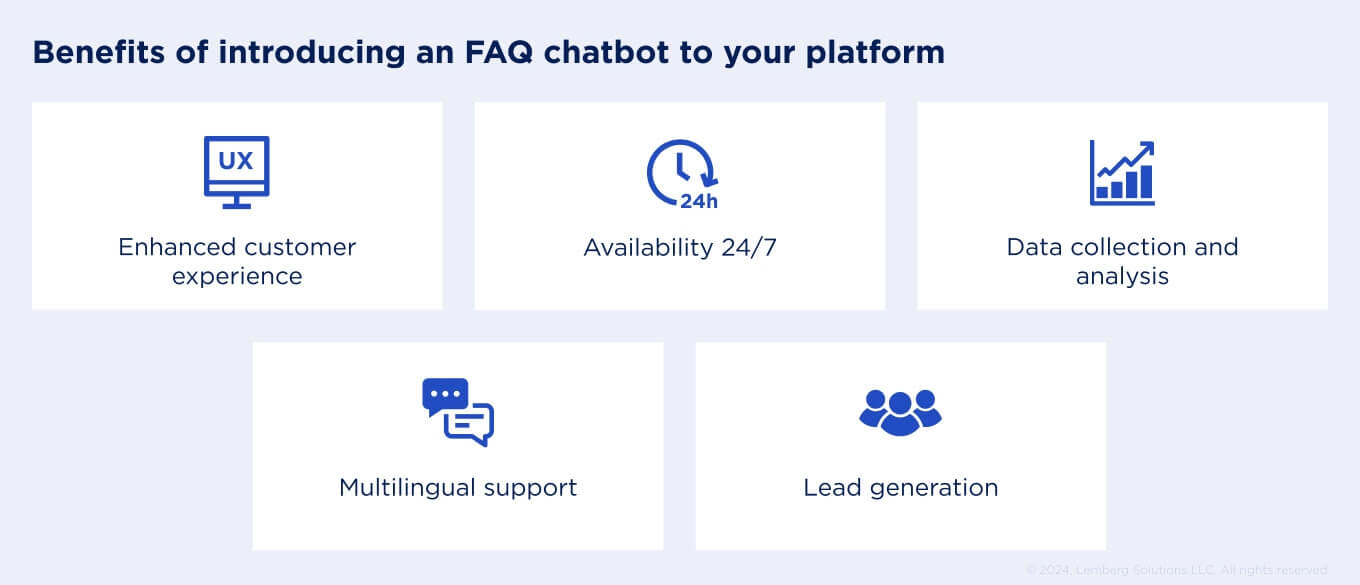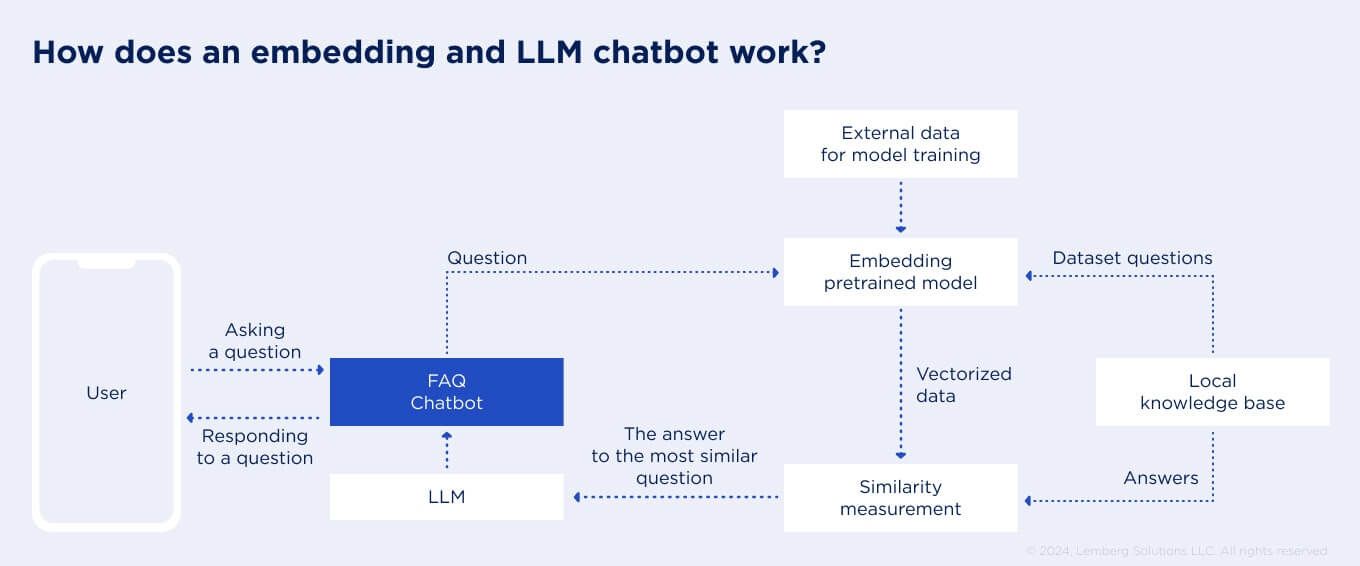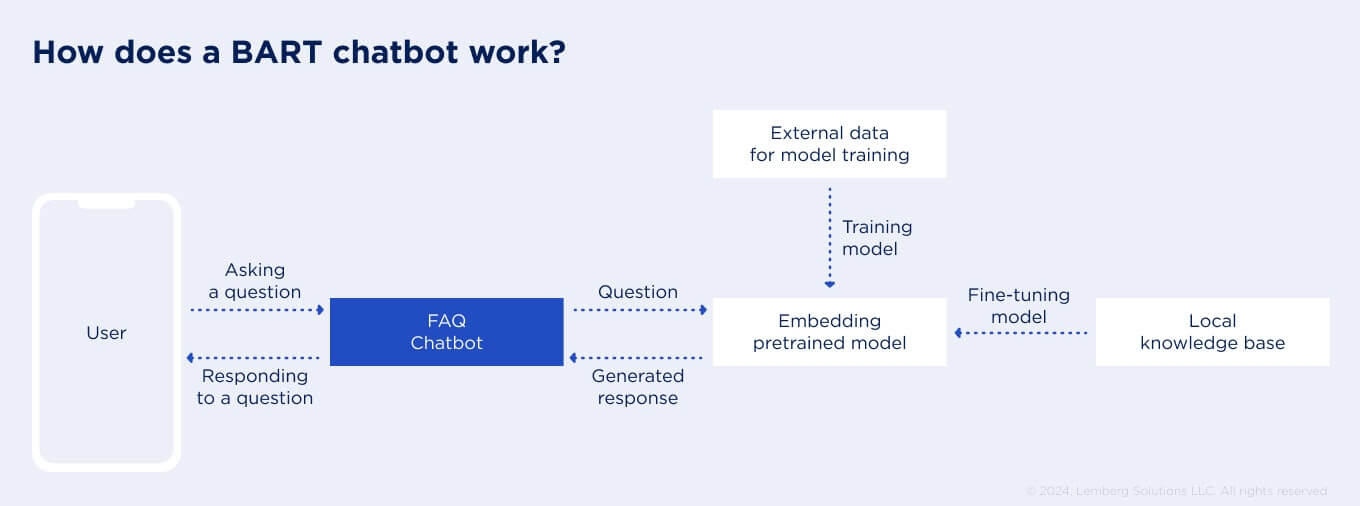Integrating FAQ or Q&A chatbot into your platform can grow your sales by up to 67%. No wonder the number of requests to build and integrate a chatbot has increased dramatically over the past few years. If you’re also looking to enhance customer experience and boost your sales by introducing an AI chatbot into your platform, you’re in the right place.
Keep reading an article by our data analyst covering the available types of chatbots based on our experience. We also provide all the background information about chatbots and their benefits you may need while deciding whether this solution fits you.
What is an FAQ chatbot?
FAQ bots are becoming increasingly popular among businesses aiming to cut expenses on support staff and enhance user experience on their platforms. There are different types of chatbots that enable users to get answers to any of their questions instantly without having to wait for a reply from support manager. This way, FAQ chatbots can increase user retention on the platform and grow the purchase probability.
FAQ chatbots are built using artificial intelligence, natural language processing, and machine learning technologies. To cut it simple, an automated chatbot analyzes the user query, compares it to the FAQ database, and depending on the context provides the most relevant answer. If the question is simple and matches one of the existing queries in database, the chatbot will provide the pre-formed answer.
However, in case the question is more complex, the chatbot will analyze it and generate a relevant answer based on the data it operates. Moreover, FAQ chatbots keep improving the quality of their responses by learning from each new iteration.
What are the benefits of FAQ chatbots?
Before building your own FAQ chatbot, carefully analyze your needs and check whether automated chatbot will solve your challenges. To help you navigate this process efficiently, we gathered the most widespread benefits of introducing an FAQ chatbot into your platform.

- Enhanced customer experience
You can improve user experience by introducing an FAQ chat into your platform. But how exactly does it work? The answer is simple like this — whenever your visitors send a question in the chatbot of your website, they get immediate answers to their requests. This also increases their likelihood to buy your services. Your website users won’t have to wait for a customer support expert to answer all of their questions. Instead, they’ll get instant access to all the information about your product or service they need. Overall, automated chatbot will build positive impression and trust among your visitors.
- Availability 24/7
Around the clock automated customer support opens new horizons for your business. In the first place, you don’t need to hire support specialists working non-business hours, which would otherwise cost you at least 1,5-times the regular hourly rate. Second, chatbot can help you expand business reach globally. At the same time, it won’t require heavy investments. All you need is a qualified team of engineers and historical data to train the chatbot.
- Data collection and analysis
FAQ chatbots collect data non-stop, as they operate 24/7. This enables continuous analysis of customer behaviour and detection of similar patterns. As a result, your chatbot keeps improving continuously, enhancing customer experience even further and eventually boosting your sales. Besides, you can also use the data collected by the chatbot to adjust your business and marketing strategies to the needs and requirements of your customers.
- Multilingual support
Multilingual chatbot will extend your market reach. You don’t need to hire support experts speaking foreign languages, as you can introduce multi-language capabilities to your chatbot. You can either choose a real-time translation service or train your chatbot in a foreign language in advance. Whatever the choice, you’ll eventually benefit from an increased customer flow from your target regions.
- Lead generation
An FAQ chatbot can enhance your lead generation processes by automating lead qualification and segmentation. Sounds too good to be true? In fact, it works as simple like this — the chatbot asks the questions that determine the level of your potential clients’ interest in your services/products. This way, you can optimize your follow-ups and make sure you never miss out on the high-potential leads.

Lemberg Solutions’ experience building FAQ AI chatbots
Below, we share a request to develop a Q&A bot that can automatically answer customer questions. Our goal was to replace the Q&A section with a chatbot and gain several benefits from this feature.
Among the objectives the chatbot was aiming to fulfill were:
- Enhanced customer experience. Customers wouldn’t have to search for their question in a long list of Q&A section. Instead, they could directly write their question and receive an instant answer in the customer service chatbot.
- Structured data collection and analysis processes. At some points, the chatbot will run into questions from users that previously had not been covered. This way, you can better understand the needs and requirements of the target audience and as a result, provide them with all the answers they may need.
- Cut customer support resources. Additionally, we were looking to cut expenses on the round the clock support by introducing an automated Q&A bot.
One of the key predispositions of a successful chatbot is the availability of a comprehensive dataset. The dataset we used consisted of pre-written question-answer pairs about the basics of artificial intelligence. The dataset consisted of 503 rows of questions and answers pairs taken from Kaggle.
After reviewing the input data, let’s now get to the realization options. Keep reading for more insights about different types of faq chatbots we can build and learn how you can use faq chatbots to reach your goals.
The most feasible FAQ AI chatbot development solutions
There are three main solutions to build a highly functional FAQ or Q&A chatbot. Below, you can see a table with the accuracy results we received after analyzing each of potential chatbot solutions — TF-IDF, embeddings and LLM, and BART.
| Solution | Accuracy test 1 | Accuracy test 2 | Accuracy test 3 | Accuracy test 4 |
| TF-IDF | 99% | 99% | 99% | 54% |
| Embeddings | 100% | 99% | 95% | 79% |
| BART | 75% | 52% | 49% | 79% |
For testing, we chose the following approach:
- First test. We used the original questions (those corresponding the questions in the database), expecting a 100% accuracy.
- Second test. Tried adding one random word at the beginning, end, or any other place of the question and check whether the chatbot can still recognize and answer the question correctly.
- Third test. Tried to complicate the task by adding three random words at the beginning, end, and a random place within the question and check whether the chatbot can still cope with understanding and answering the question correctly.
- Testing with OpenAI ChatGPT. First, we prepared a test sample by using ChatGPT to generate potential questions similar to the ones we used while training the chatbot. Then, we input these questions into our algorithm and evaluated the accuracy of the received answers.
To learn more about each of the available AI chatbots algorithms that can be used to build a Q&A bot, keep reading a detailed review of each solution with a step-by-step testing and analysis. As a result, you’ll get several chatbot options to consider when choosing your perfect fit.
Chatbot based on TF-IDF (Term Frequency-Inverse Document Frequency)
The first approach we can offer is TF-IDF (Term Frequency-Inverse Document Frequency). This is a metric that evaluates the importance of a specific word (which can also be a letter or a combination of letters) in the dataset.

The TF-IDF method consists of two parts, TF and IDF:
- TF in this case indicates the frequency of the word's occurrence in the AI bot questions. It is calculated by dividing the number of times a specific word repeats in the question by the total number of words in that question.
- The IDF part shows how important the word is in relation to the whole dataset. It is calculated by taking the logarithm of the total number of questions divided by the number of questions in which this word appears.
Thus, the TF-IDF can be calculated by multiplying the results of TF and IDF:
TF-IDF = TF * IDF.
We also used the cosine similarity, a measure of vector similarity, which is applied to calculate the distance between two strings and is also used in text analysis to define similarities within the content.
After removing stopwords, using TF-IDF for vectorization, and employing k-NN and cosine similarity, we found the most similar questions in our dataset and provided the corresponding answers.
Let’s now check out the test results for the TF-IDF method:
Solution | Accuracy test 1 | Accuracy test 2 | Accuracy test 3 | Accuracy test 4 |
TF-IDF | 99% | 99% | 99% | 54% |
- The first test showed a result of 99%, with five questions predicted incorrectly out of the total of 503. Each of the questions used during the first test corresponded to a question present in the dataset. However, the questions we used had one character that was different from the original question. For example, we used the question "What is f(n)?" and the algorithm provided the answer to "What is g(n)?" instead.
- The next test also gave 99% accuracy in all cases, with the same problem as in the test number one — after asking a question with one different character, the model failed to provide a correct answer.
- The third test yielded similar results, but this time, the algorithm failed at predicting three questions instead of five.
- The fourth test showed up to 74% accuracy. For this test, we adjusted the ChatGPT to low-temperature setting to reduce its creativity. At the standard temperature of 0.5, the accuracy was down to 54%. The received results can be explaines by the algorithm's reliance on finding similar questions without considering context. This leads to the following conclusion — significant changes in the question without sufficient number of keywords result in incorrect answers.
Chatbot based on embedding and LLM (Large Language Models)
Another chatbot FAQ example is embedding and LLM. This approach has a fundamental similarity to the previous one — it provides answers from the existing dataset. This approach holds several advantages, especially if you’re dealing with a specific domain and lack a large dataset.

Similarly to the previous approach, it can also be divided into two parts:
1. The conversion of sentences into numerical vectors.
2. The use of cosine similarity to find the most similar questions.
First, we converted our entire dataset into embedding vectors and saved them. Next, we transformed the questions into similar vectors. Then, using cosine similarity, we searched for the most similar questions in the dataset and provided answers that are paired with those questions. We also utilized the Retrieval Augmented Generation (RAG) architecture to further enhance the capabilities of the LLM.
For testing, we used the same steps as in the previous approach.
Check out the test results we received with Embedding and LLM approach:
| Solution | Accuracy test 1 | Accuracy test 2 | Accuracy test 3 | Accuracy test 4 |
Embeddings | 100% | 99% | 95% | 79% |
- The first test resulted in 100% accuracy, as we expected.
- The accuracy of the second test made 99%, with one incorrect answer given in each testing case.
- The average accuracy among these tests was 95%. Compared to the previous TF-IDF approach, embedding and LLM proved to be less effective in handling noise when a random word was added at the beginning, end, or any other part of the question.
- The fourth test gave us a result of 79% accuracy. The incorrect answers can be explained similarly to the previous scenarios: the chatbot was looking for similar questions without properly analyzing the context.
Chatbot based on custom LLM model training (BART)
The last approach we’ll consider is BART (Bidirectional and Auto-Regressive Transformers). BART is a transformer (seq2seq) model that uses a two-way (BERT-like) encoder and an autoregressive (GPT-like) decoder. BART is pre-trained to analyze the text both from the left and right directions in the sentence, which eventually improves the quality of the chatbot answers. By contract to the previous two approaches, this one doesn’t retrieve data from the existing dataset and instead, generates answers on the go.

To test this approach, we first prepared the dataset using a tokenizer from the pre-trained model “facebook/bart-base.” After this, we fine-tuned the pre-trained model “facebook/bart-base” using the Hugging Face dataset.
For testing, we used the same steps as in the previous approach.
Test results of the BART model accuracy:
Solution | Accuracy test 1 | Accuracy test 2 | Accuracy test 3 | Accuracy test 4 |
BART | 75% | 52% | 49% | 79% |
- The accuracy of this model is evaluated based on the similarity between the original and generated answers using cosine similarity with a threshold of 0.6. A similarity score above 0.6 is considered a correct answer. As a result, we achieved 75% accuracy in the first test.
- This test was evaluated like the previous one and gave a result of 52%.
- With the same score as previous tests, we obtained results of 49% here.
- In the last test, we achieved the best result of 79%.
This model is intended for more complex tasks involving extension of questions’ context, which was not among our initial objectives. This approach is much better at perceiving the paraphrased questions because it can understand the context. However, to achieve better results, it's necessary to expand the dataset. Enhancing the chatbot by adding context is a topic that deserves a separate article, thus, we won’t further cover it in this article.
Conclusions after considering three types of chatbot solutions
The TF-IDF and embedding approaches are similar in some respects. Thus, the choice between them will depend on several factors such as your budget, speed of operation, and the size of the question-answer pairs dataset. TF-IDF is cheaper and simpler to implement and use. However, its drawback is lower accuracy with questions that significantly differ from those specified in the dataset.
Transformer models like "BART" are more complex solutions for bots aiming to replace a Q&A or FAQ section. These models require a larger dataset with context and significantly more computational power to perform well. However, they offer the advantage of generating responses rather than just retrieving those from your dataset.
The embeddings and LLM approach proved to be the best option for solving our task, as it performs better than TF-IDF and requires less data and resources compared to models like BART.
Summing up
After reviewing three main types of solutions for implementing an AI chatbot, you can define your best-fit approach. If you still hesitate which solution would fit you, drop us a line, and our experts will analyze your specific business case and come up with comprehensive answers to your requests.


